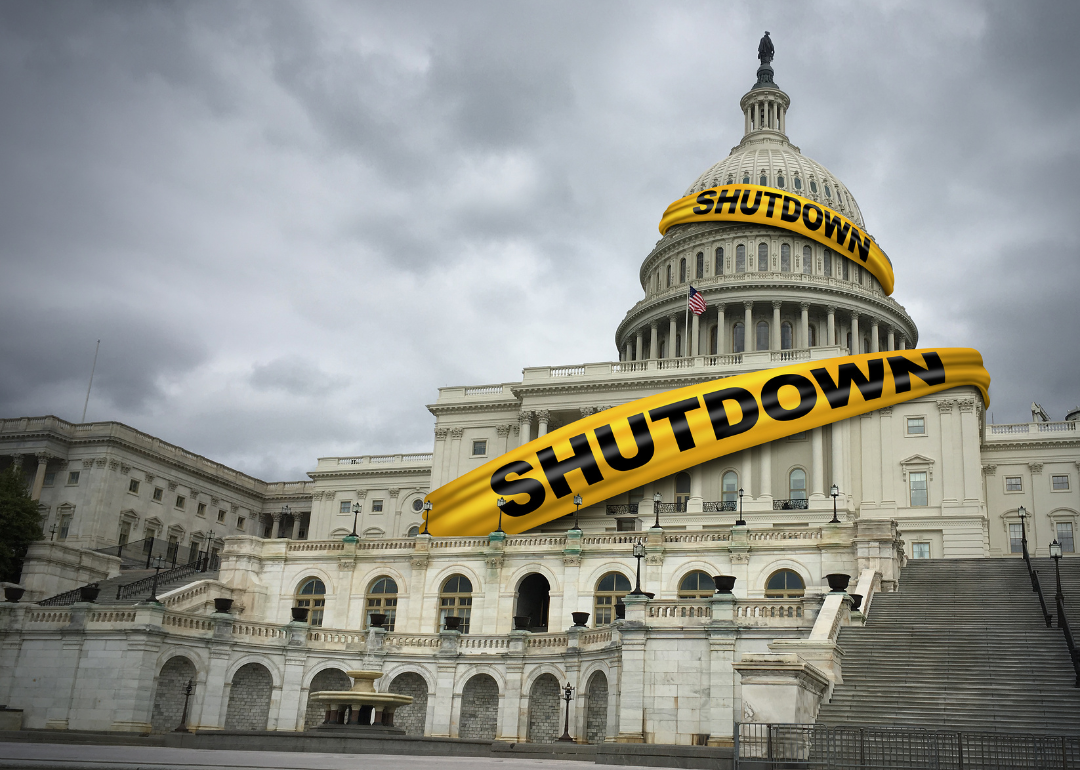
A government shutdown halts pay for 2.8 million federal workers. Here's where it would hit them hardest
A government shutdown halts pay for 2.8 million federal workers. Here's where it would hit them hardest
Just hours before the impending deadline on September 30, 2023, lawmakers passed a bill that averted a government shutdown until November 17. This last-minute effort set forth a chain of events that ended with the historic ousting of Rep. Kevin McCarthy, R-Calif., from his position as Speaker of the House. On November 16, President Biden signed a bill extending stop-gap measures to fund the Departments of Transportation, Agriculture, Housing and Urban Development, and Veterans Affairs through Jan. 19 of next year and all remaining federal agencies and services until Feb 2, 2024, to allow Congressional legislators more time to sort out a long-term spending bill.
A government shutdown occurs when Congress doesn't authorize federal funding, leading to a suspension of federal employee duties except those deemed essential. With approximately 2.8 million federal government workers (as of March 2023), the federal government is the nation's largest employer. A government shutdown would result in a temporary loss of $5.3 billion for these employees and have financial implications that could extend beyond missing paychecks.
MoneyGeek analyzed Census Bureau data to understand the impact that a government shutdown would have on federal government workers by congressional district. We also used employment and wage data from the Bureau of Labor Statistics for metro areas and states to learn about the implications of a government shutdown on a broader scale.
Key findings
- Rep. Matt Gaetz, R-Fla., who initiated the vote to oust former Speaker Kevin McCarthy, R-Calif., represents Florida's 1st district, which has the 18th-highest concentration of federal employees in the country (7%).
- Federal employees are narrowly divided amongst Democrat (53%) and Republican (47%) congressional districts.
- A government shutdown could freeze wages for over 150,000 individuals in Maryland, home to the highest percentage of federal employees (6%). In California-Lexington Park, Maryland, where 22% of residents are federal employees, the potential monthly wage loss exceeds $10,000.
- The South would face the highest lost wages during a government shutdown, with a potential loss of about $2.3 billion per week. The Northeast faces the lowest impact, with an estimated freeze of around $668 million per week.
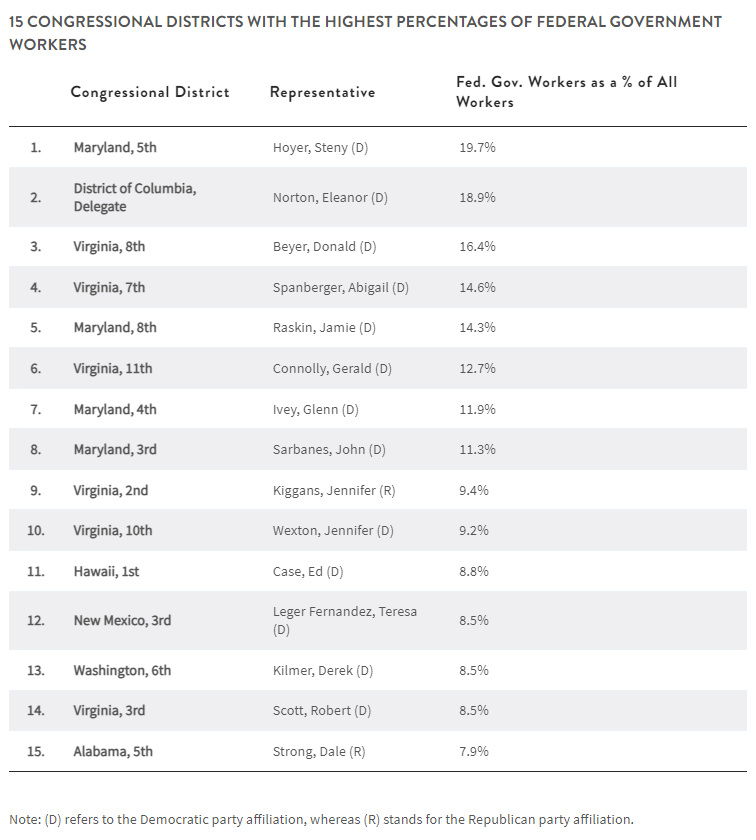
Mapping federal employment in Congressional districts
Given their proximity to the nation's capital, nine out of ten congressional districts with the highest percentage of federal workers are in Maryland and Virginia. The densest is Maryland's 5th district, where the federal government employs 20% of the workforce.
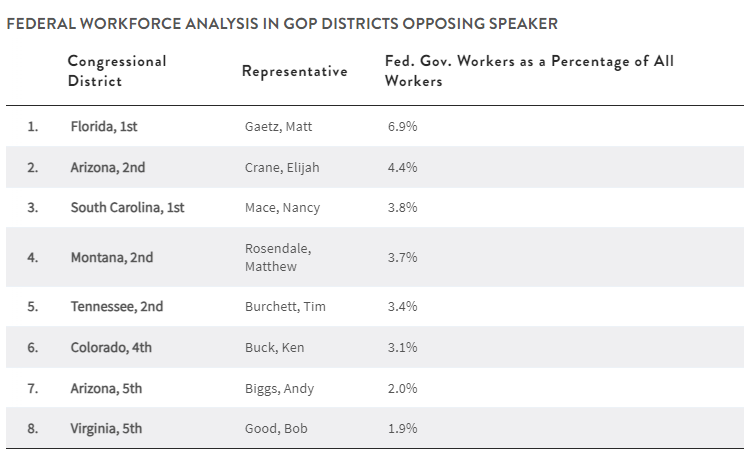
Federal employees in the House Majority districts
Represented by Rep. Matt Gaetz, — who initiated the vote against former Speaker McCarthy — Florida's 1st district is home to approximately 25,000 federal employees (7% of the local workforce). Of the seven other Republican representatives who supported the Speaker's removal, Arizona's 2nd district ranks next with 4% of its workforce in federal sectors.
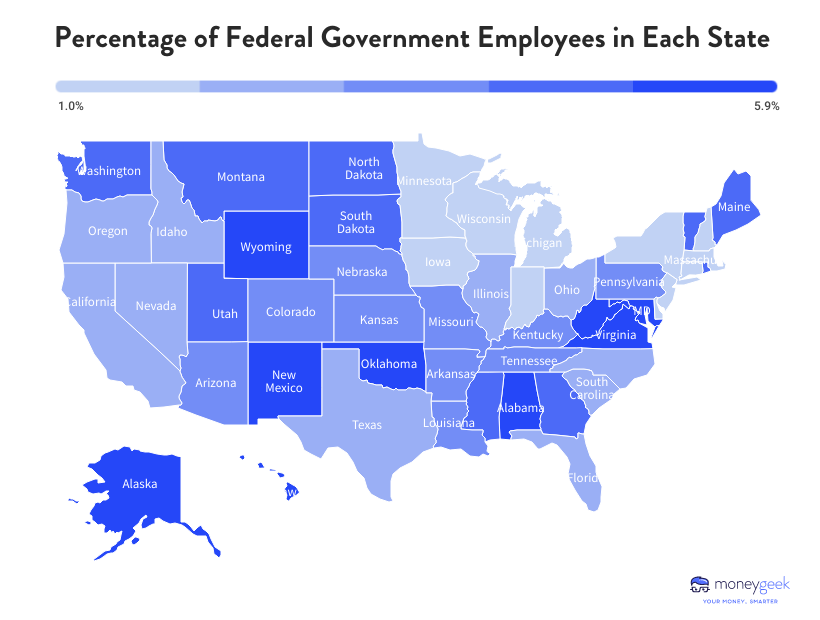
Most federal government workers live in Southern States
MoneyGeek also examined the distribution of federal government workers and the potential impact on wages for these individuals at state and metropolitan levels.
Maryland stands at the forefront with roughly 155,000 federal government workers, making it the state that would face the most significant impact from a government shutdown. These individuals represent 6% of the local workforce, and a shutdown of just one week could mean $378 million in unearned wages. Next are Hawaii and Alaska, where 5.5% and 5% of the workforce are federal employees, respectively. A shutdown in these two states could freeze $88.7 million per week in wages.
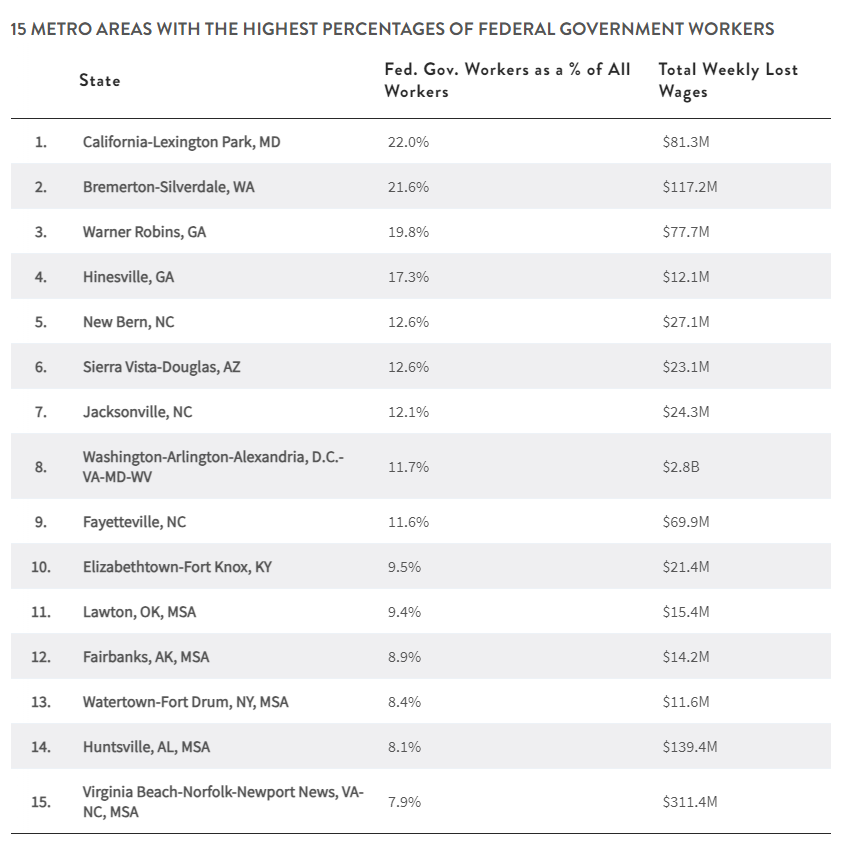
Honing in on metropolitan areas, California, Maryland, and Washington, D.C., lead with the highest average weekly wages for federal employees, surpassing $2,500 per person
The California-Lexington Park metro area has the highest percentage of federal workers at 22%, while farther west, the Bremerton, Washington, area holds the second-highest concentration at nearly 22%. Closely following are select metro areas in Georgia and North Carolina, where federal employment exceeds 12% of local populations.
What can federal employees do about a shutdown?
Although temporary — laws ensure retroactive payment upon resumption — the pay halt caused by a government shutdown can disrupt workers' financial stability and affect their ability to manage routine expenses or service debt. Small businesses may also experience processing delays for lending and lost profits, which can trickle down and impact workers. Here are some proactive measures to navigate this financial hiccup:
Stay informed
- Familiarize yourself with the Federal Employee Civil Relief Act, which (if enacted) would allow a debt payment forbearance post-shutdown.
- Understand the provisions of the Government Employee Fair Treatment Act, which mandates retroactive pay for furloughed employees or those working without pay during the shutdown.
- Keep abreast of guidance from the Office of Personnel Management (OPM) regarding pay and benefits during a shutdown.
Budget and save
- Smart saving strategies allow you to build a financial cushion that can help mitigate the impacts of delayed wages.
Communicate with creditors
- Inform lenders about the temporary halt in your income and negotiate extended payment terms if needed.
Methodology
MoneyGeek utilized Quarterly Census of Employment and Wages (QCEW) reporting by the Bureau of Labor Statistics (BLS) for state and metropolitan area data to determine the areas with the largest percentages of federal government workers relative to the total local workforce and their average weekly wages. Data is from the first quarter of 2023 and considers all 50 states and 381 metropolitan areas.
For federal government employee data in U.S. congressional districts, we used the Census Bureau's 2022 1-year American Community Survey. Our list of representatives and the 436 districts they represent came from the U.S. House of Representatives directory.
Limitations: The BLS QCEW excludes the following groups from the category of "federal government": "elected officials in the executive or legislative branch, members of the armed forces or the Commissioned Corps of the National Oceanic and Atmospheric Administration, individuals serving on temporarily in case of fire, storm, earthquake, or other similar emergency, and individuals employed under a Federal relief program to relieve them from unemployment."
This story was produced by Moneygeek and reviewed and distributed by Stacker Media.



